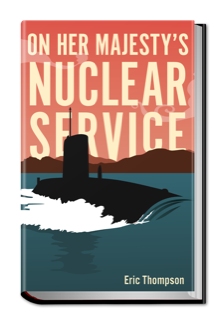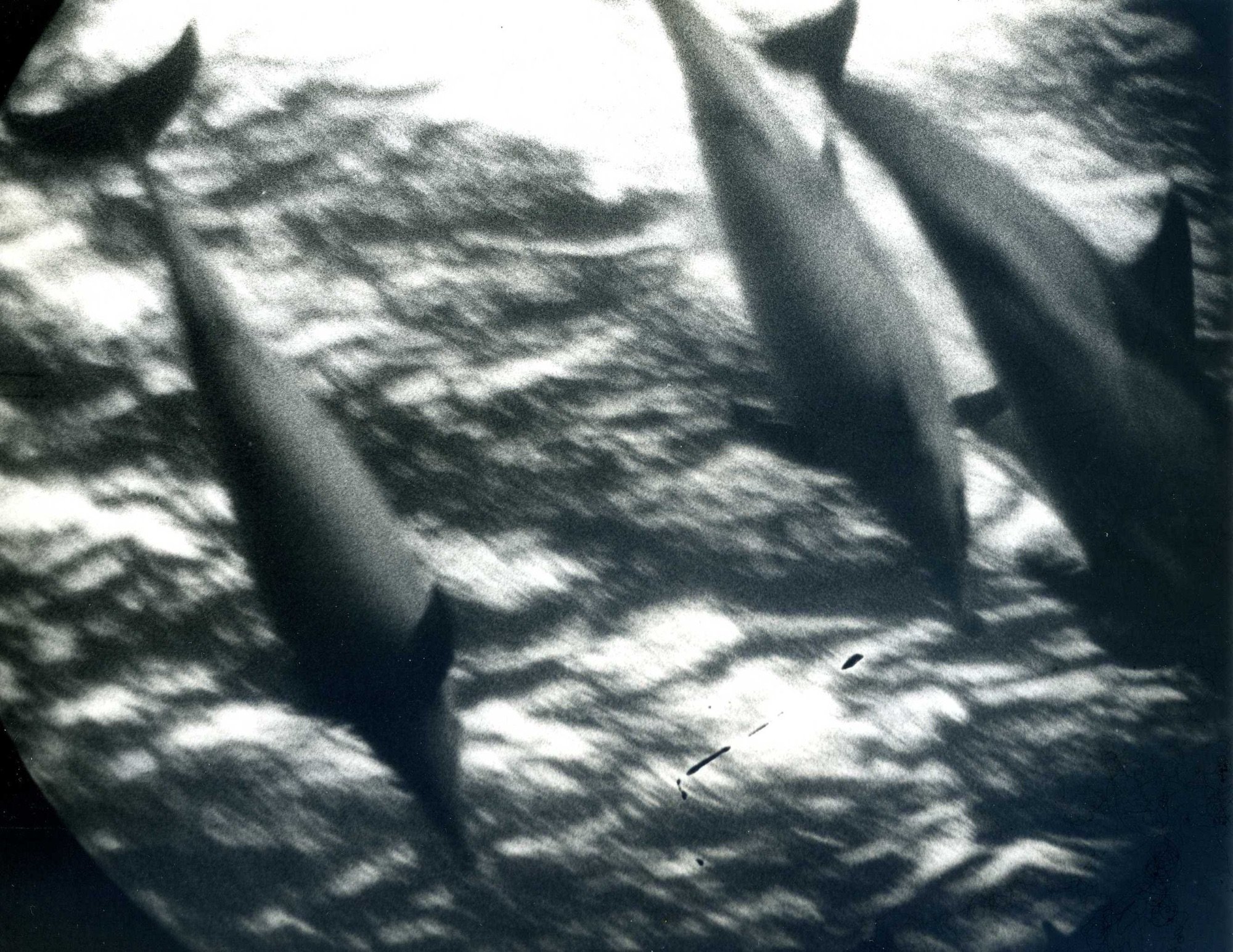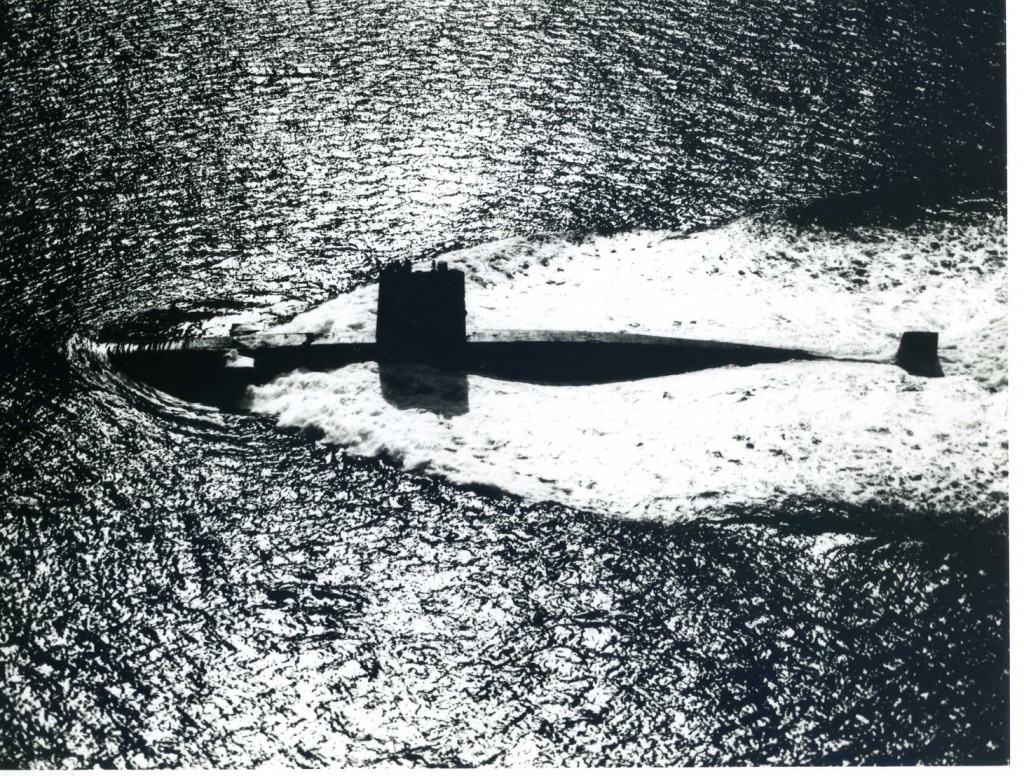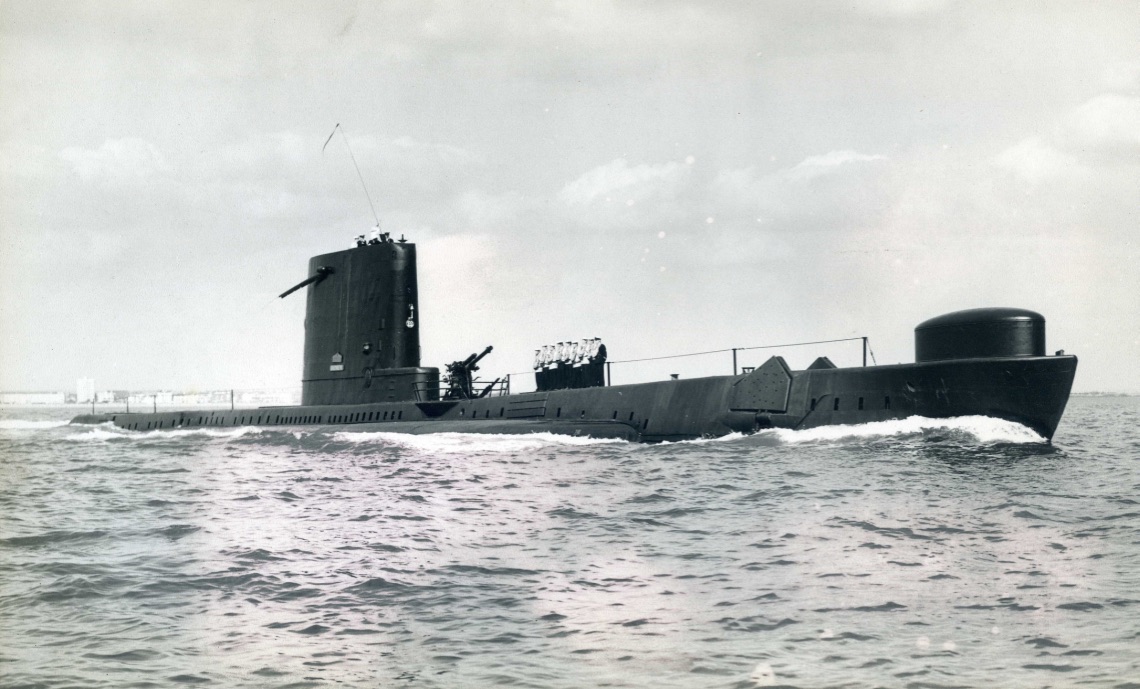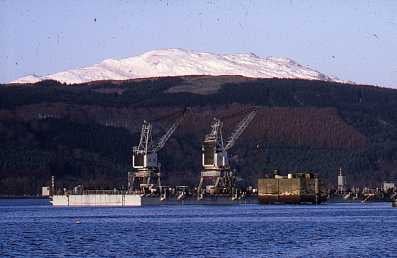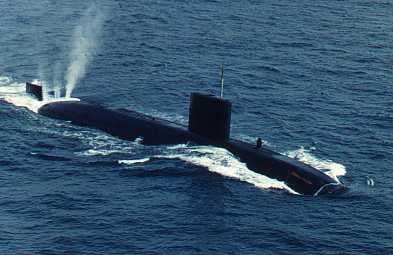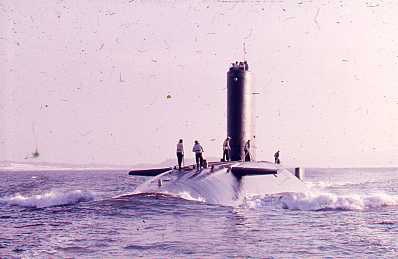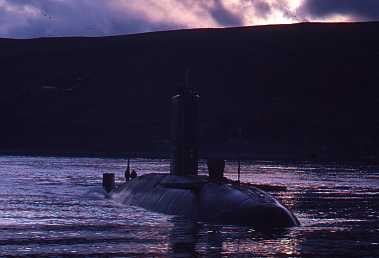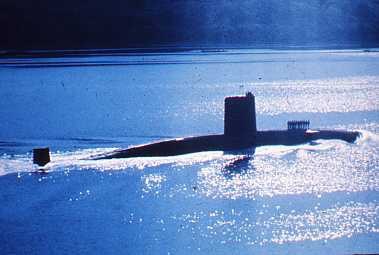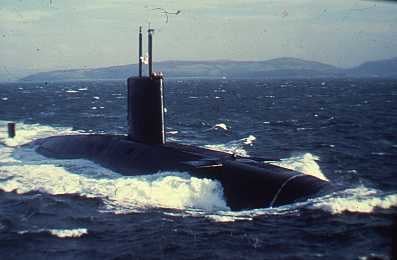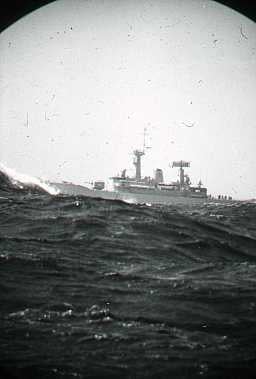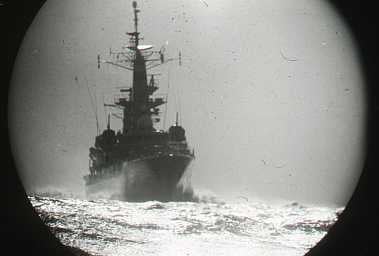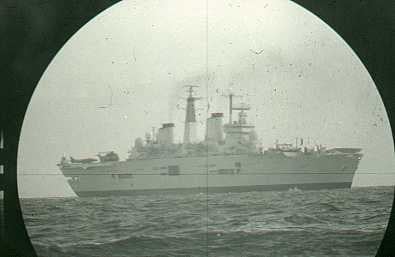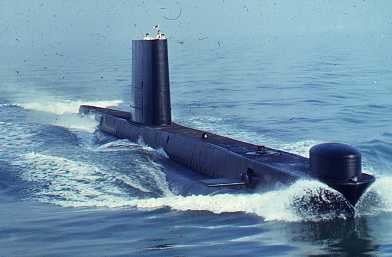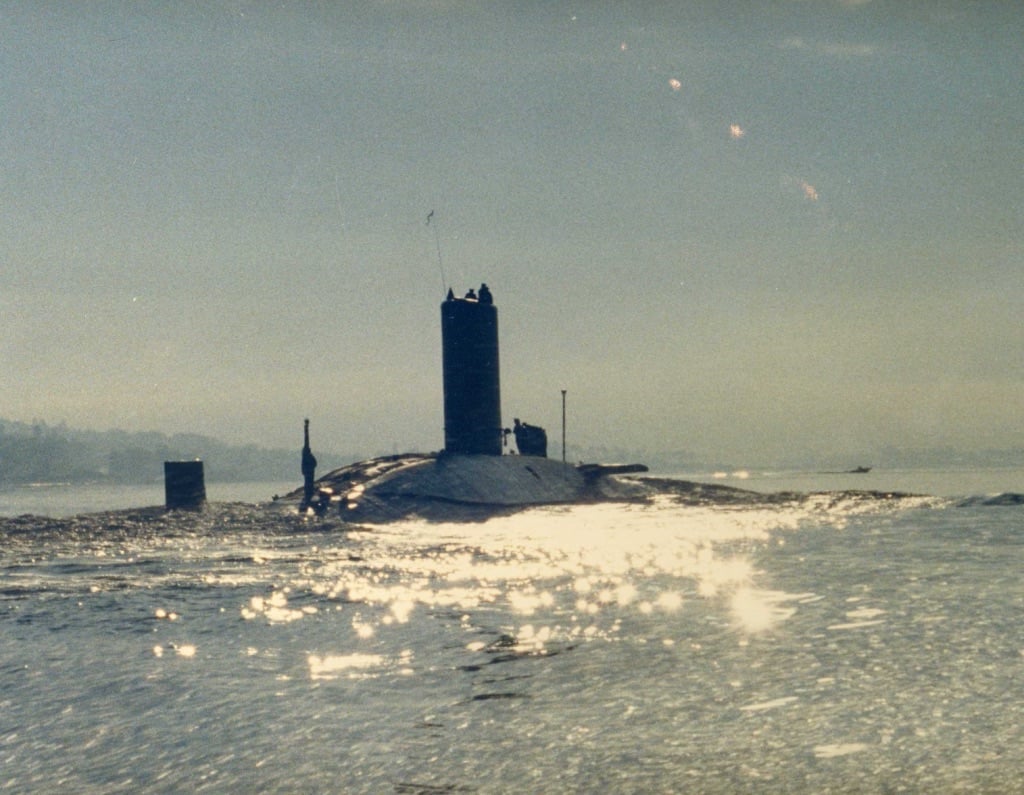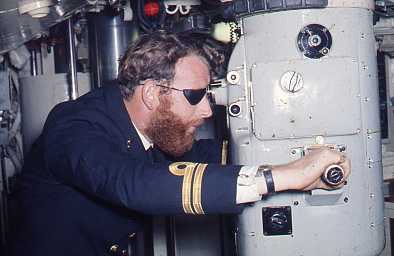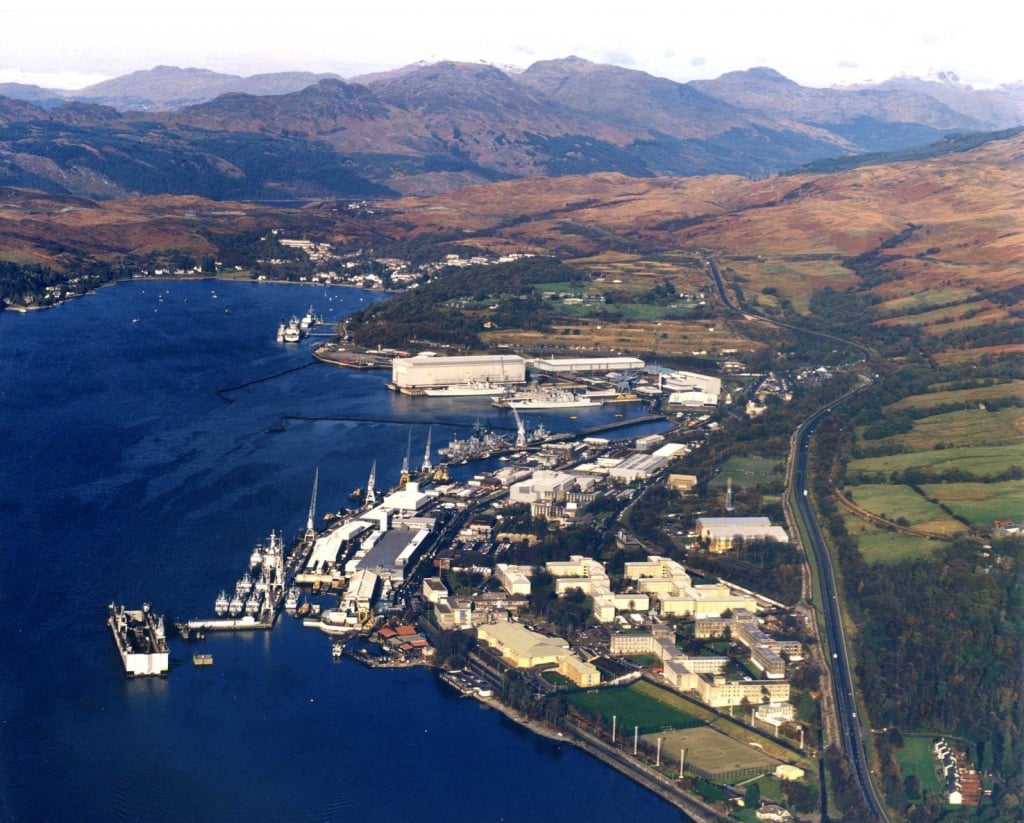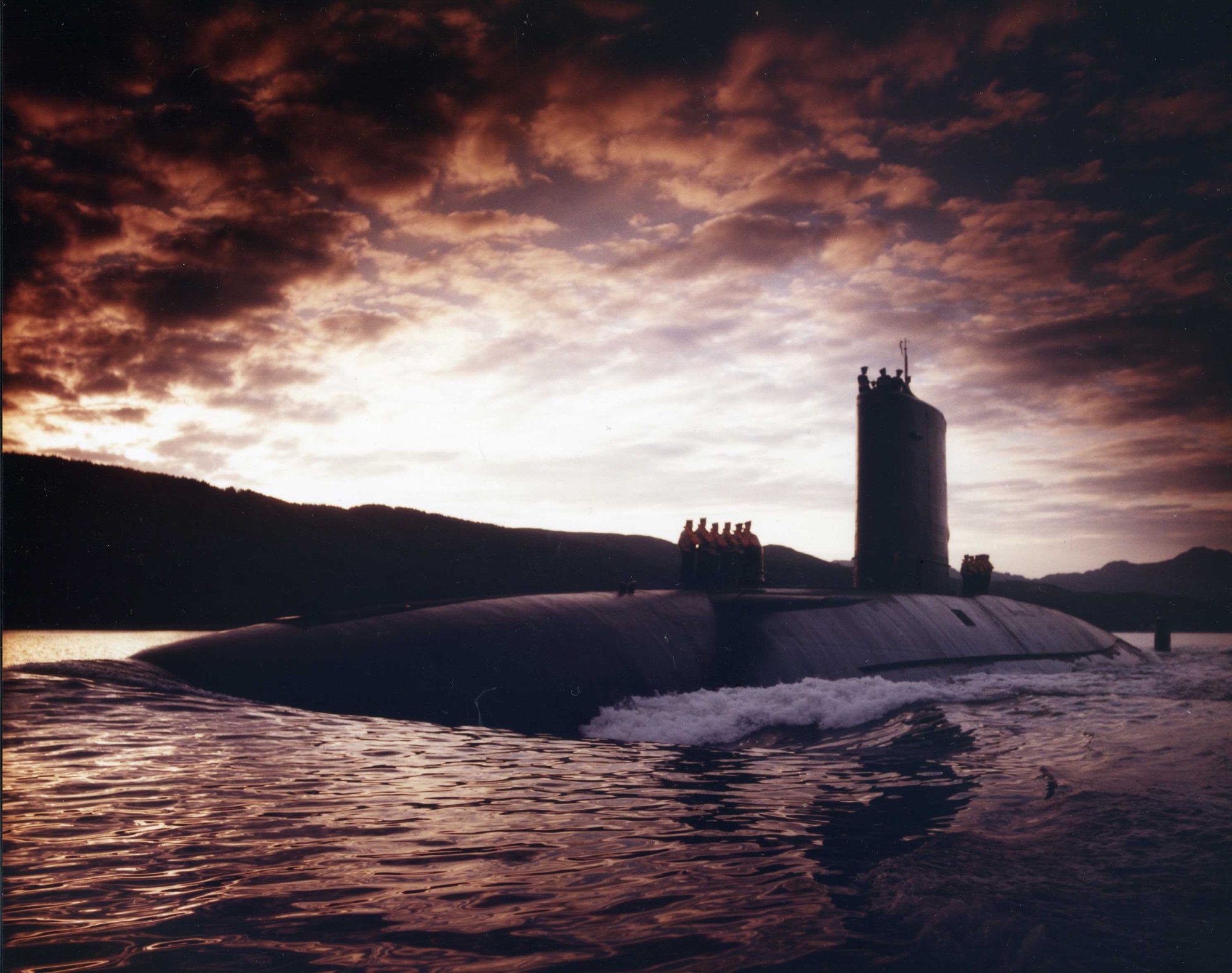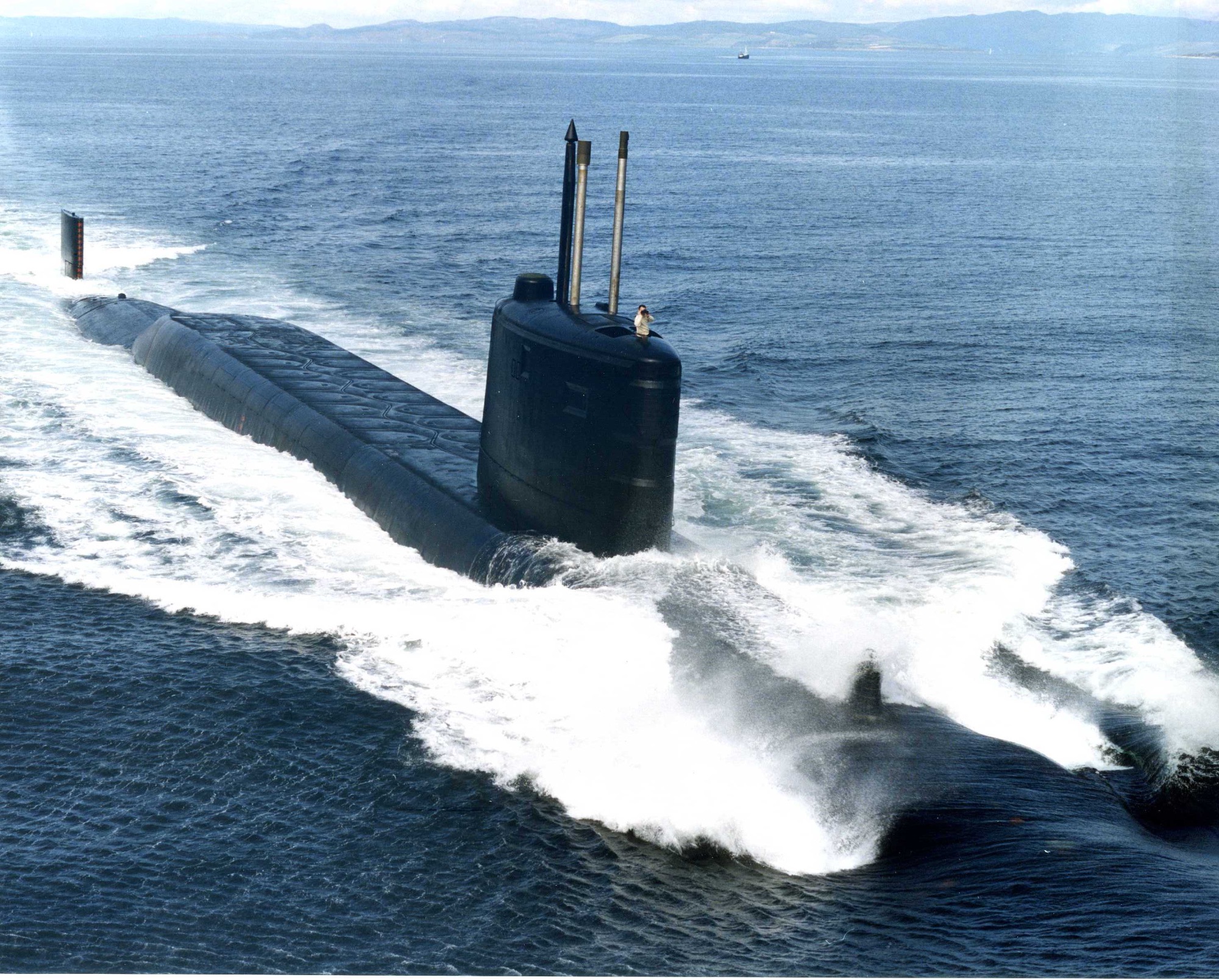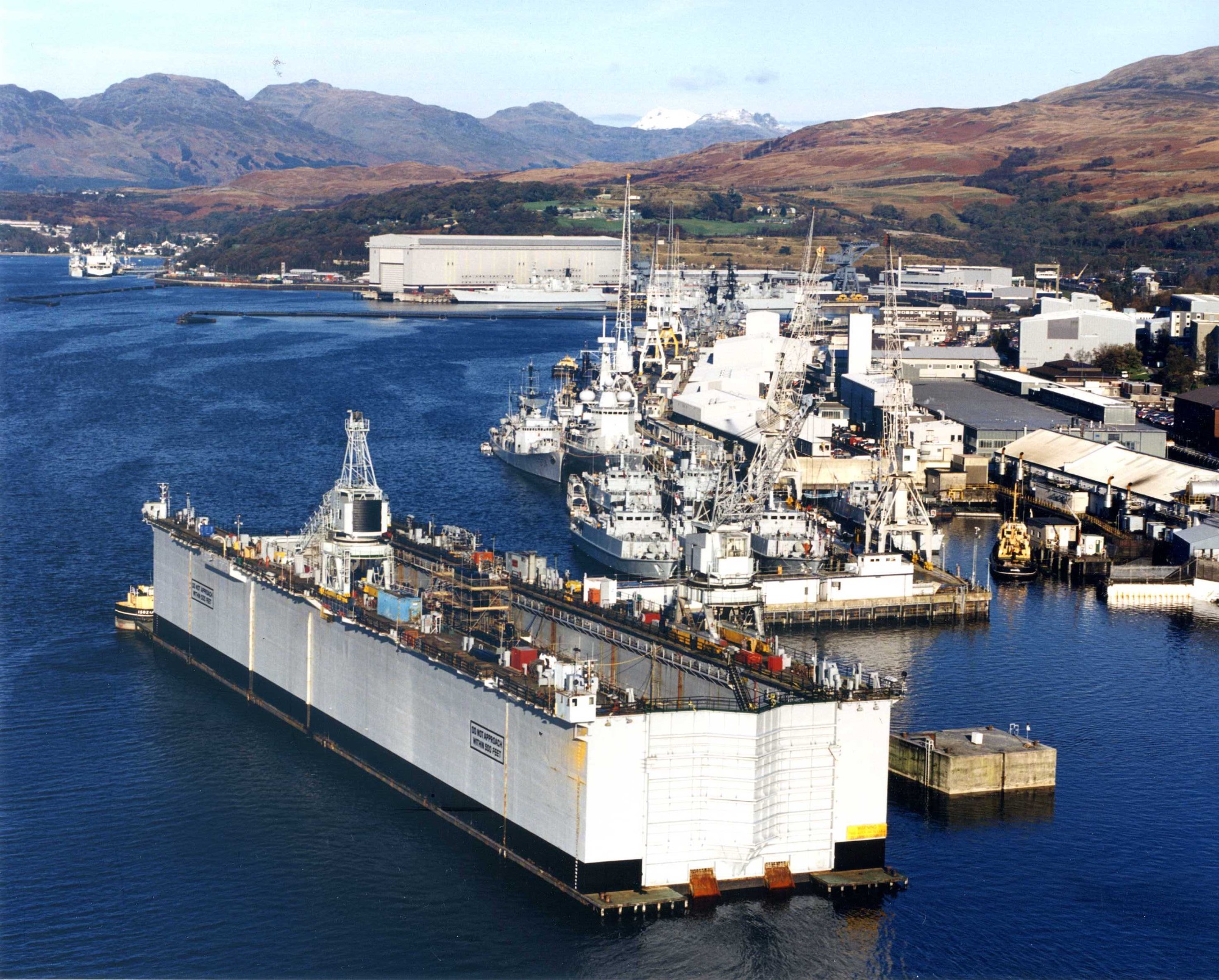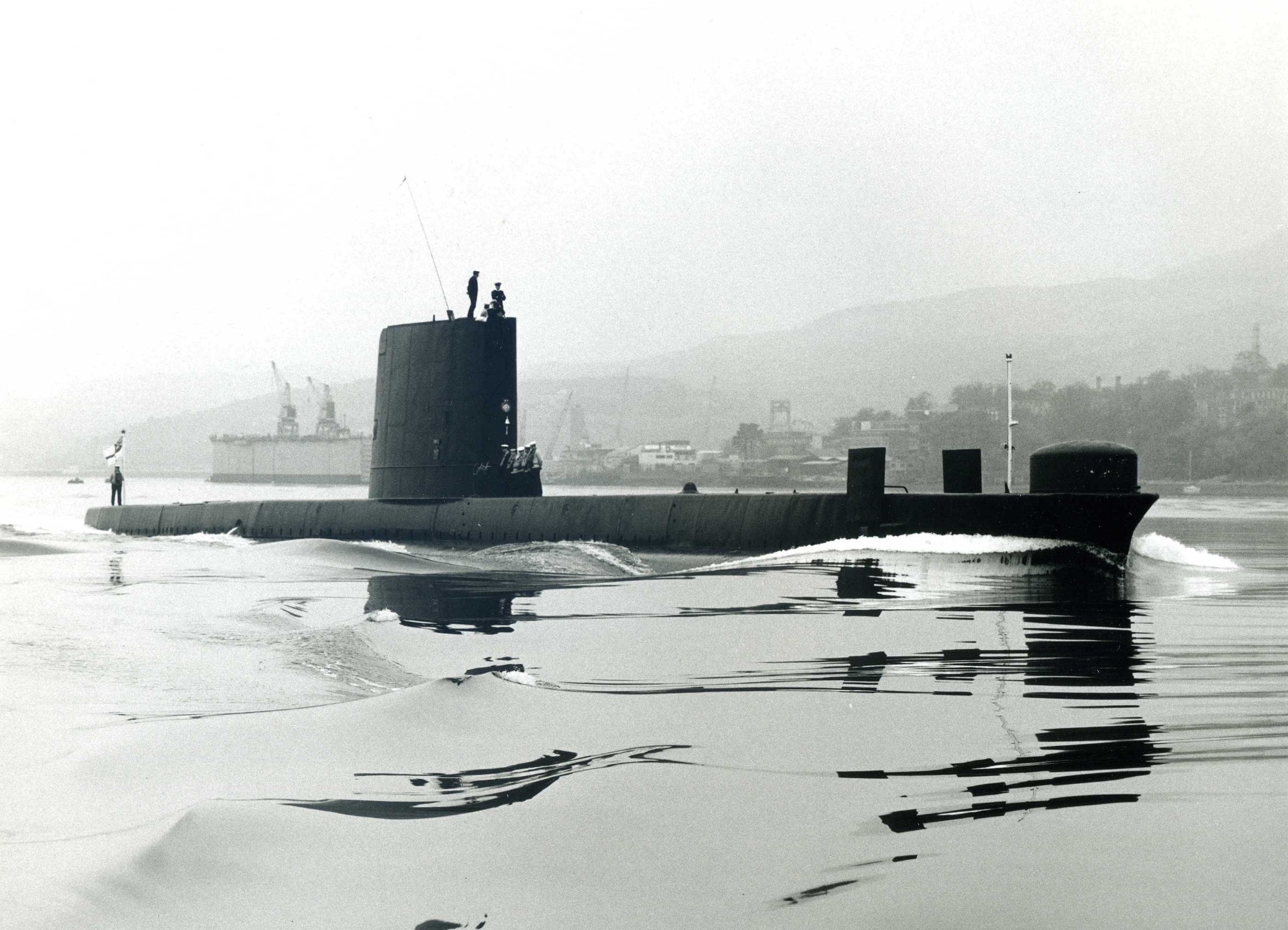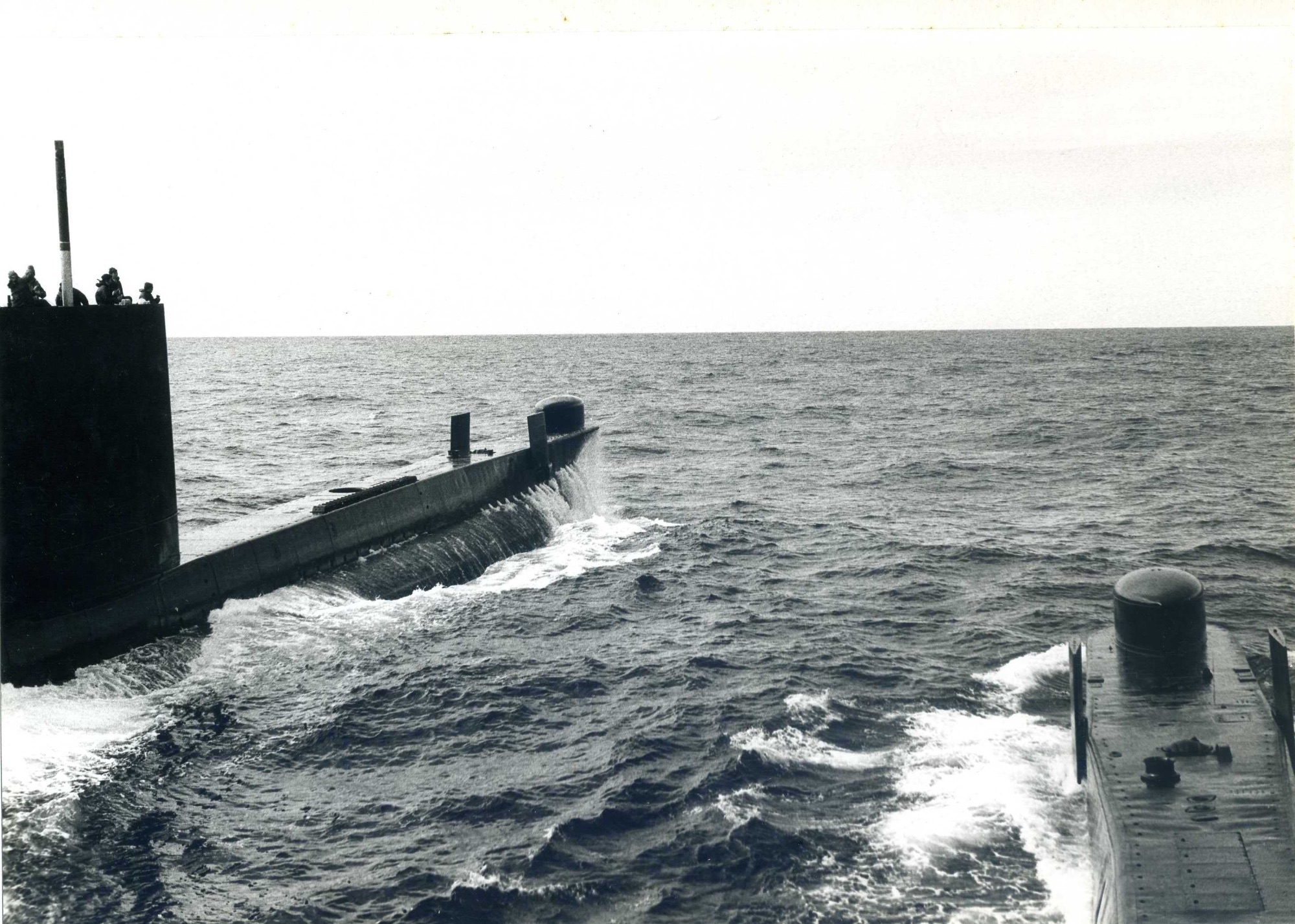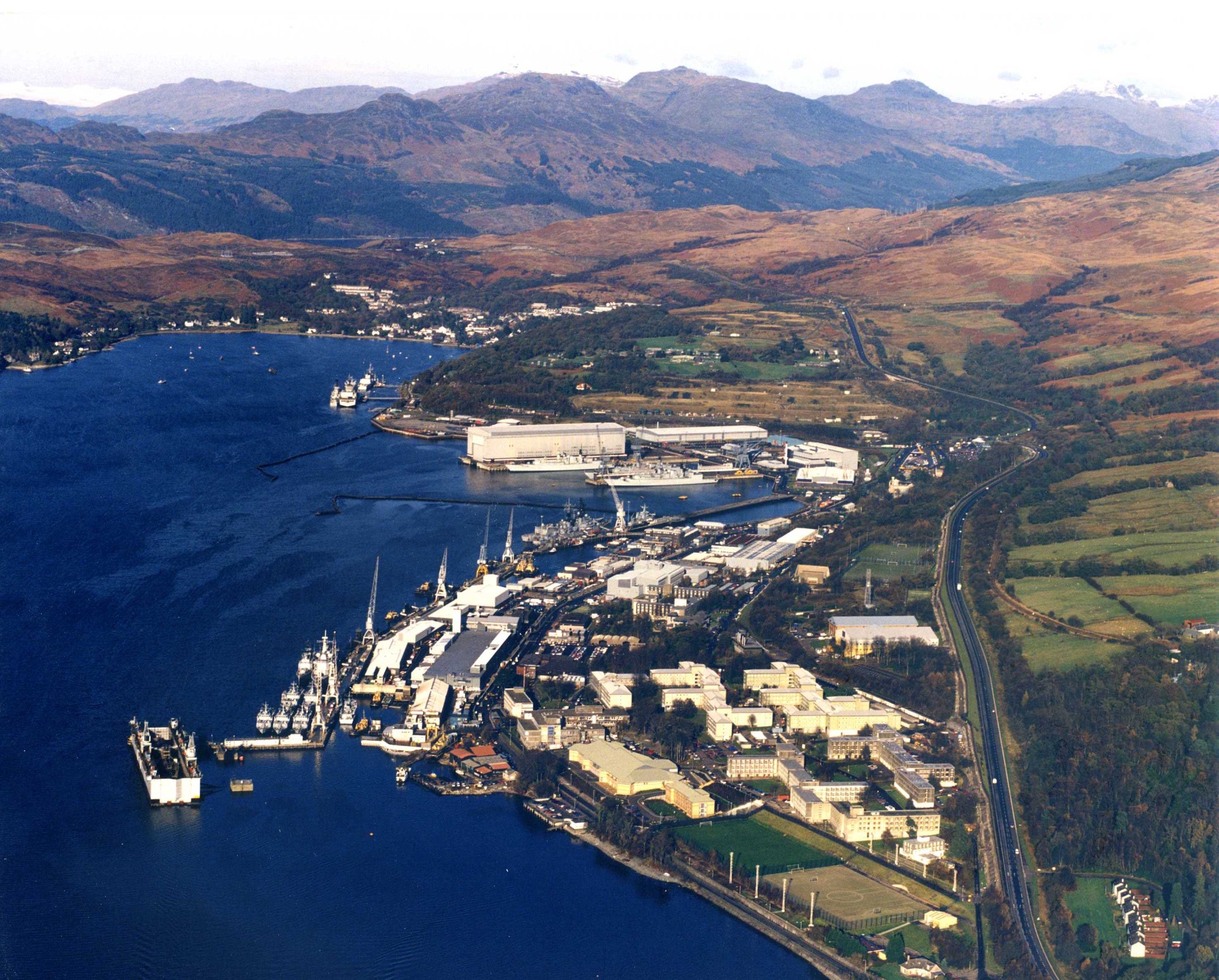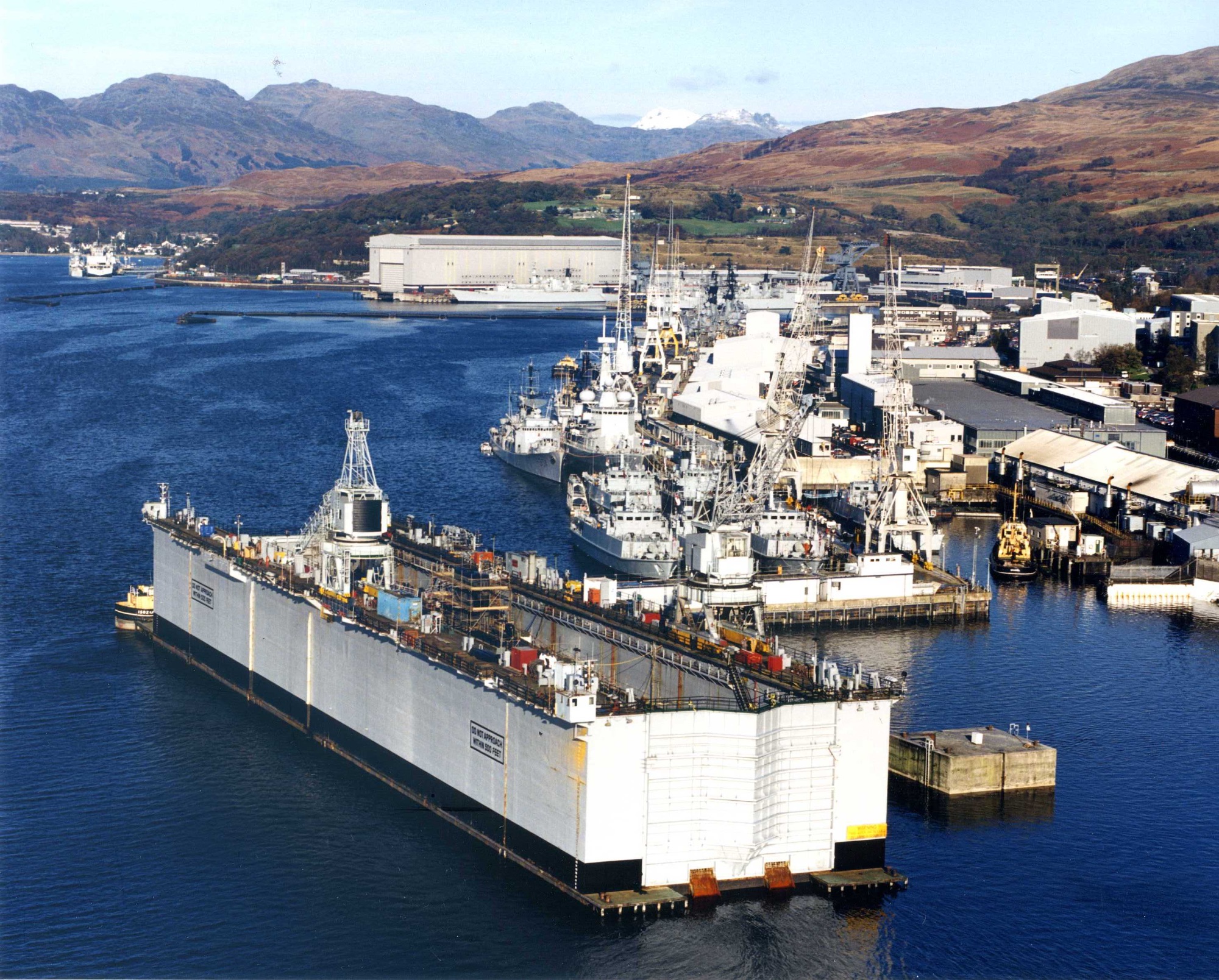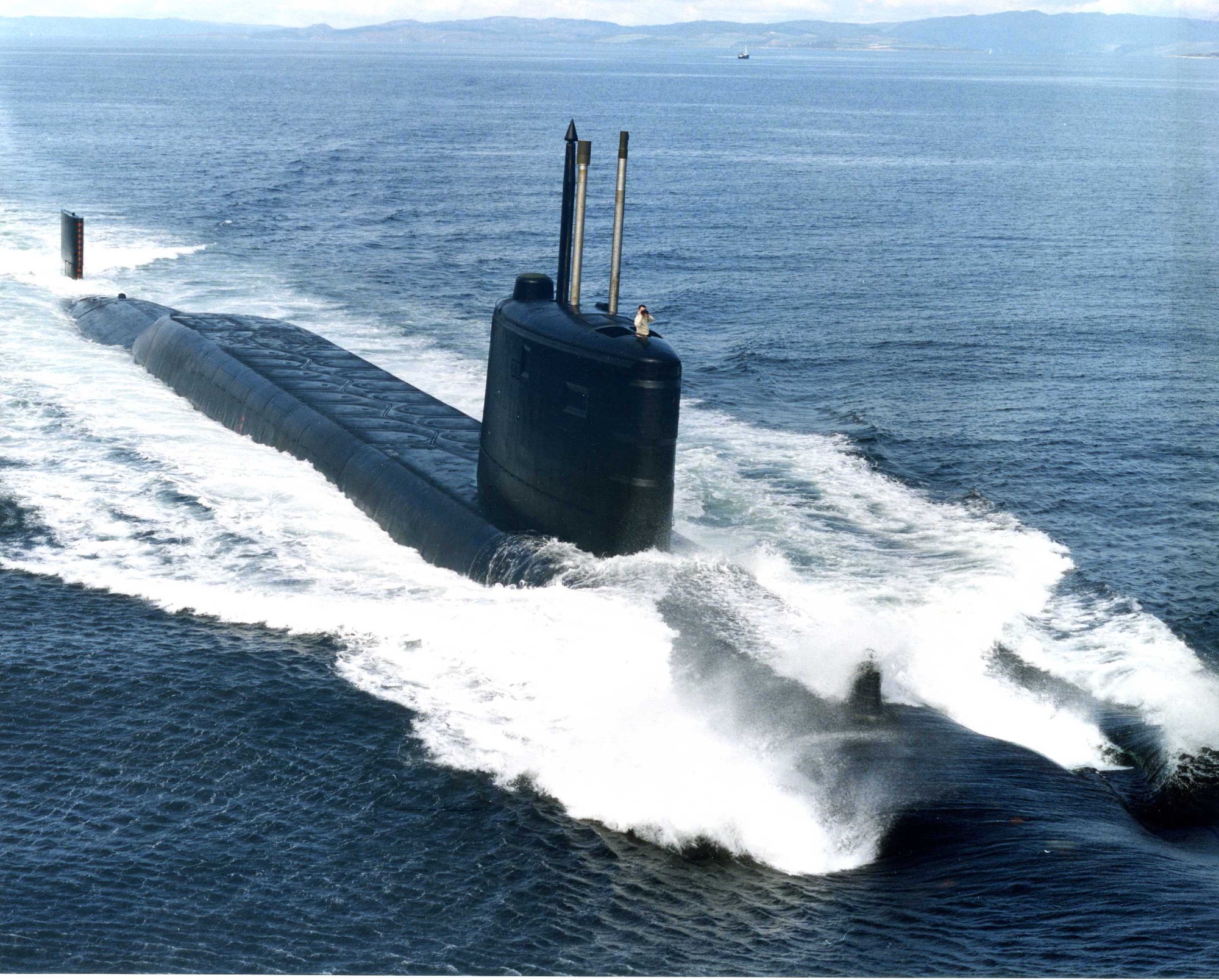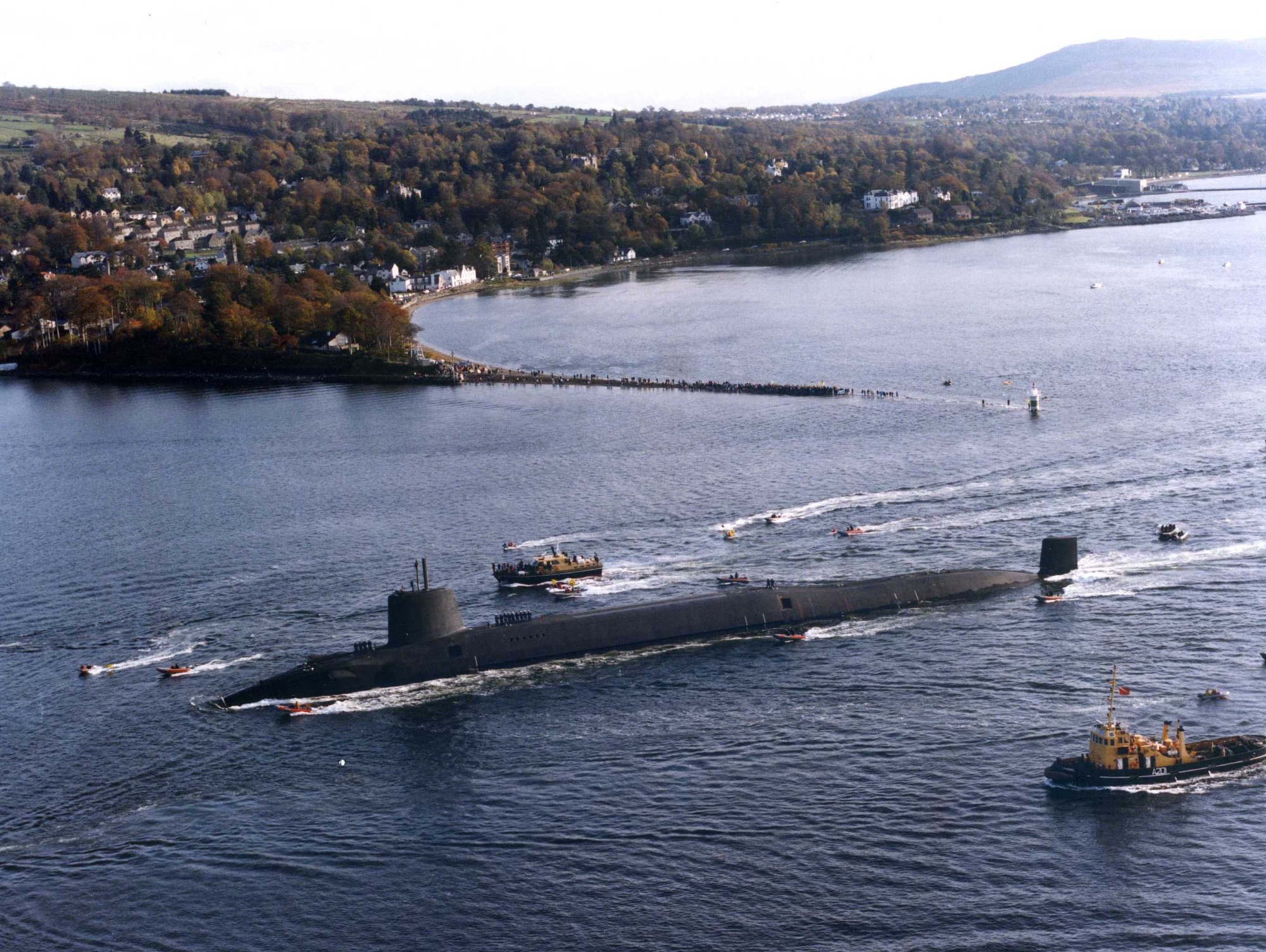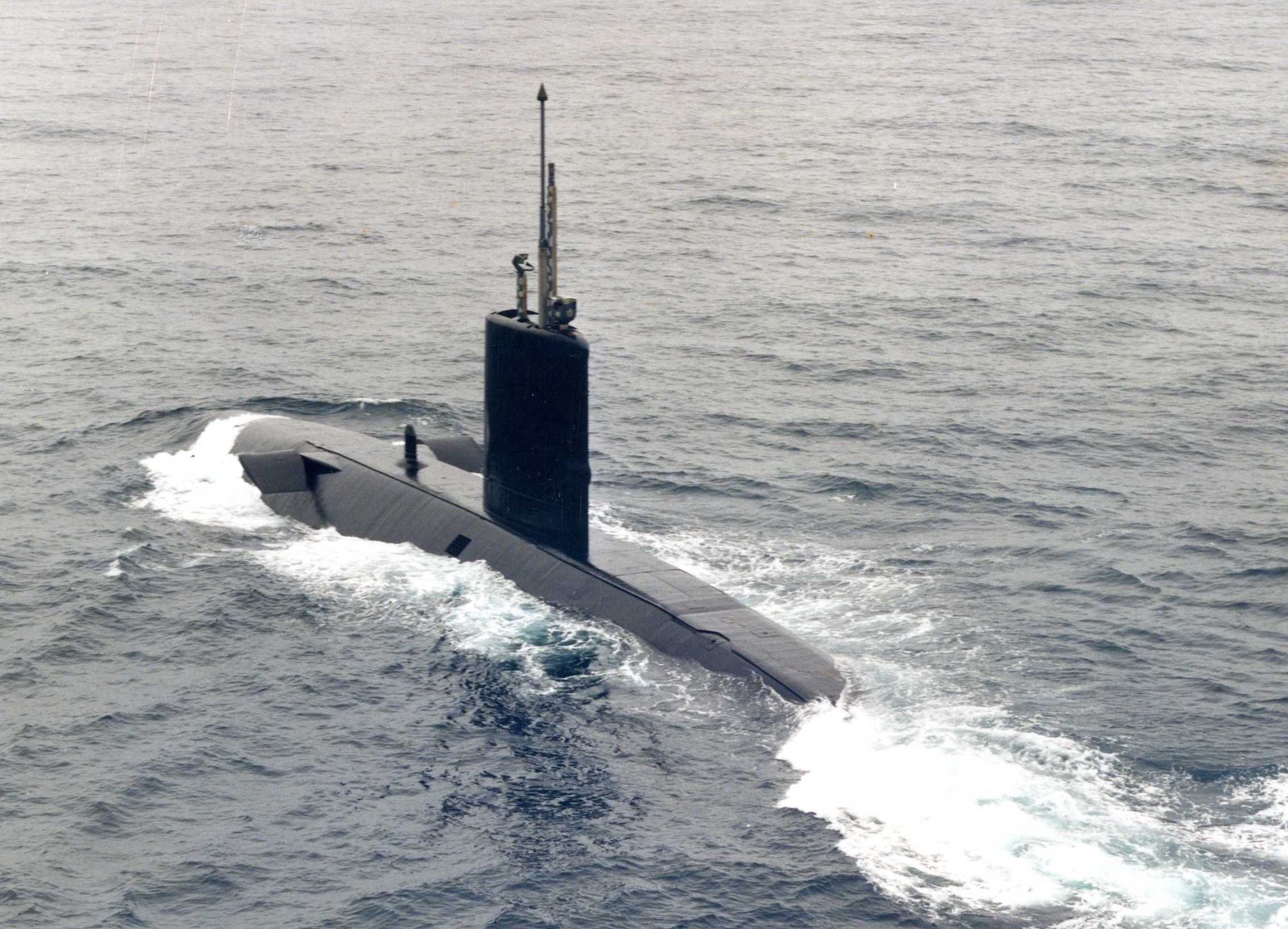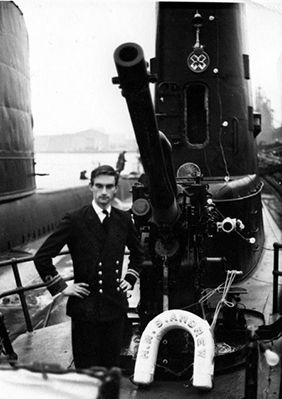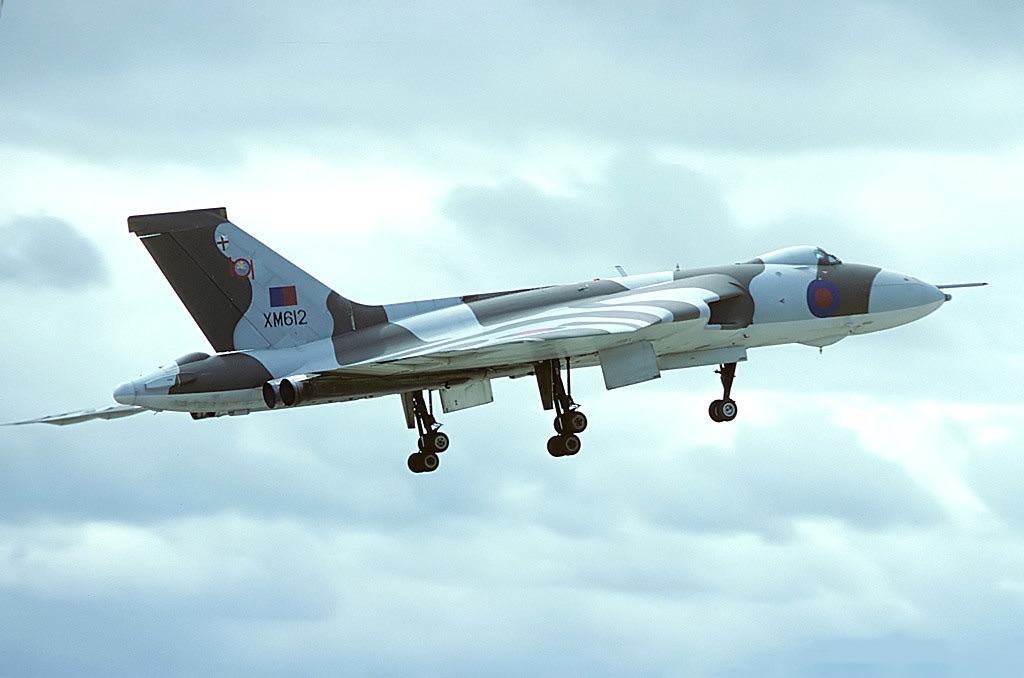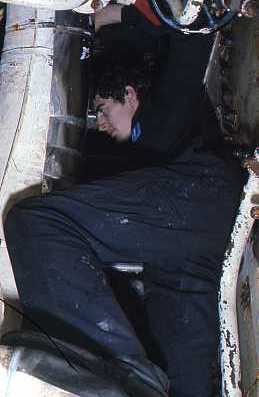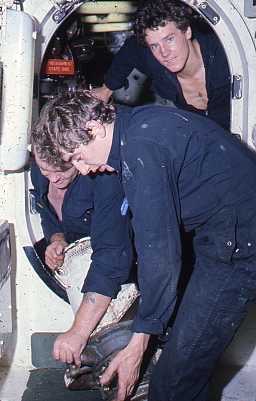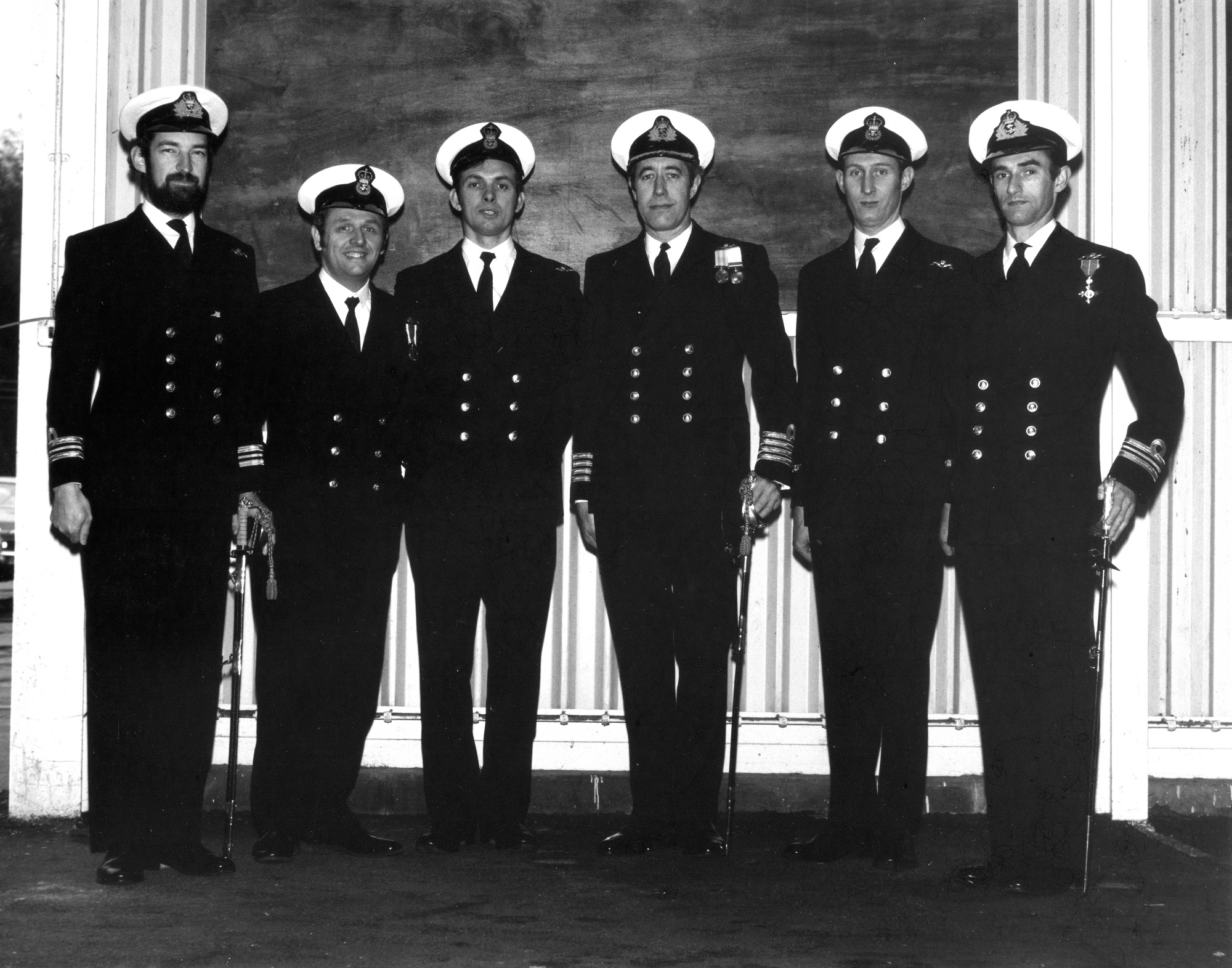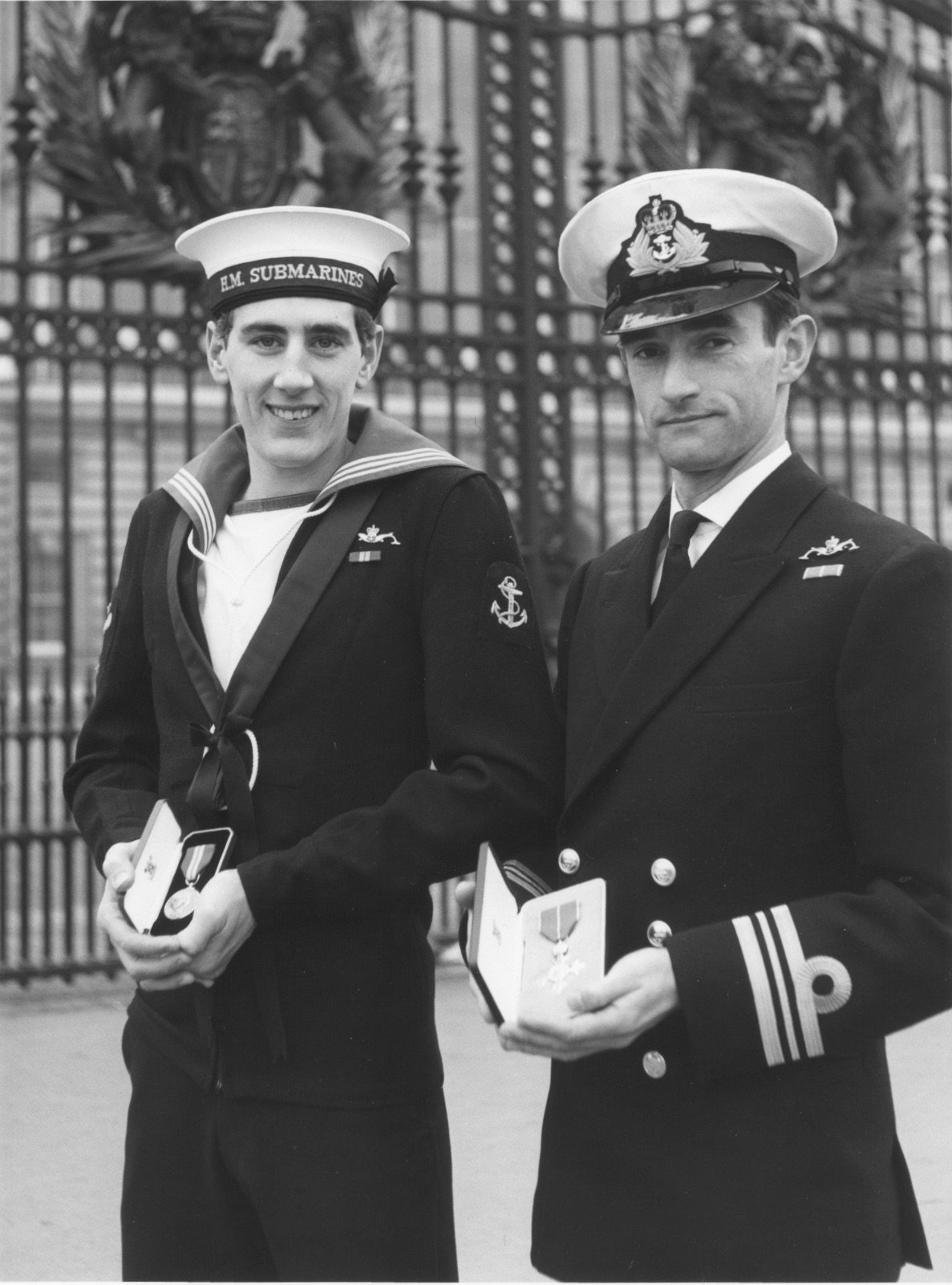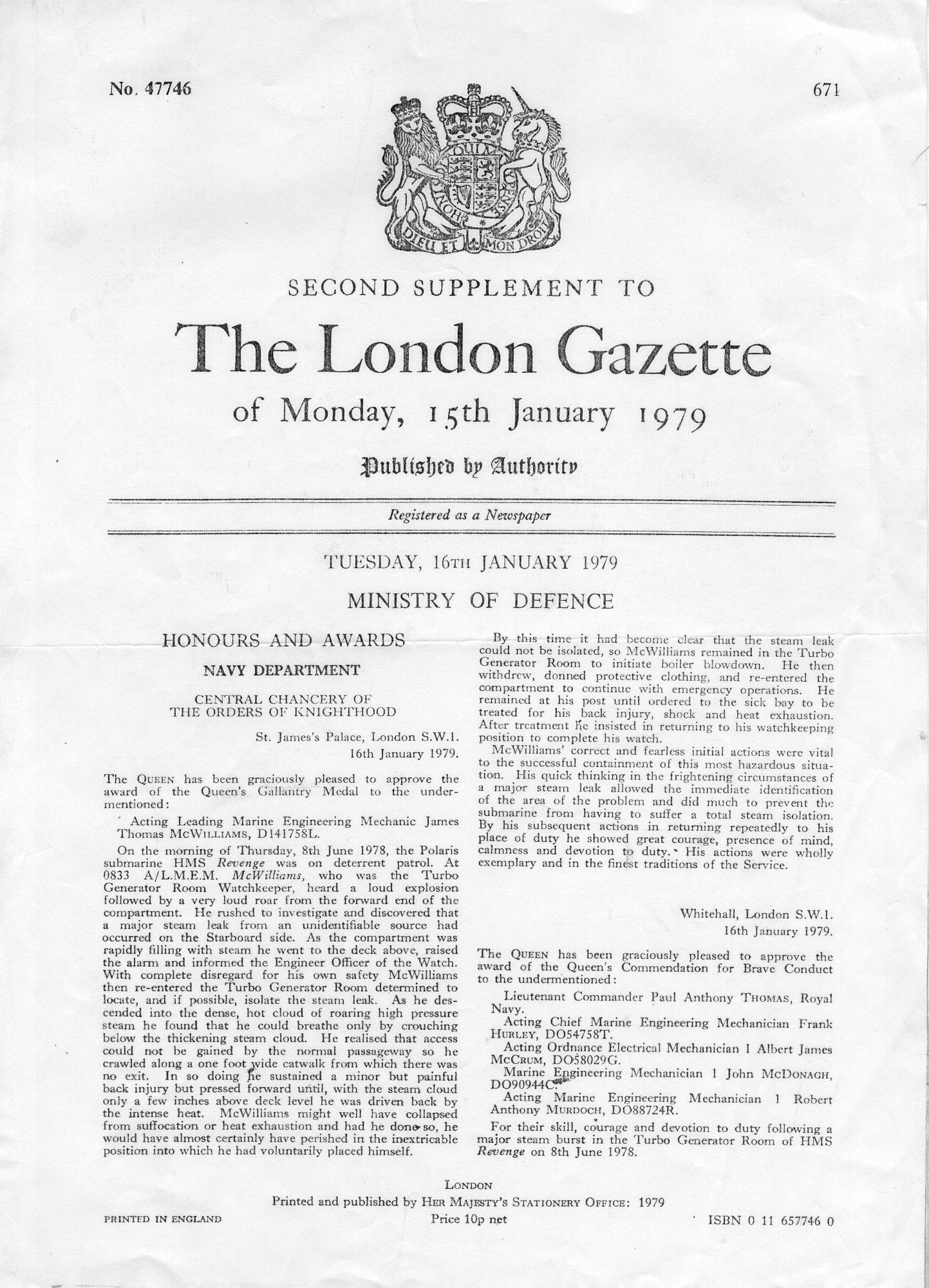INTERVIEW WITH DAN SNOW ON BOARD HMS ALLIANCE
In 2019, TV presenter and historian, Dan Snow, interviewed me in HMS Alliance at the RN Submarine Museum in Gosport. In January this year (2022) a veteran submariner in New Zealand contacted me with questions about A Class submarines. He had seen the interview on Youtube. I had not. Sure enough, there it was. Not only that but there were loads of comments on it, many wondering about my age!! To view the interview, click on the picture below (and Skip Adverts)
Submarine Gallery
Mission Accomplished

I commissioned Leslie Diaper, a local artist, to paint this picture for me as my retirement gift to the Navy. It seemed a fitting gift as the Polaris programme had spanned my career almost exactly. The painting now hangs in the Wardroom, HMS Neptune, at Faslane. The Polaris boats had been the country's duty peacekeepers for twenty-eight years.
I gave Leslie several photographs of Polaris submarines to help him and also took him out in the Queen's Harbourmaster's Launch to observe HMS Vanguard, our first Trident submarine and successor to the Polaris boats, leaving Faslane. That gave him the backdrop of the Gareloch and the atmosphere of one of these mighty submarines leaving for patrol. The painting is therefore a composite. Repulse would not have been travelling at this speed within the confines of the Gareloch.
HMS Repulse de-commissioned on 23rd August 1996. From 1968 until the end of the Cold War in 1990 and beyond until 1996, our four Polaris submarines, RESOLUTION. RENOWN, REVENGE and REPULSE had maintained an unbroken sequence of 229 strategic nuclear deterrent patrols and had been ever ready, at fifteen minutes notice, to launch Britain's nuclear counterstrike in response to a nuclear attack on Britain by the Soviet Union - a feat achieved thanks to the quality and determination of the crews and the impressive support facilities of the Clyde Submarine Base. In 1996, they handed the peacekeeping baton over to the new genration of Trident submarines (ordered during the Cold War).
Of course, the Soviets never did launch a nuclear attack because they were well aware of the damage they would suffer in return. That was the principle of Mutually Assured Destruction. As Kruschev, the Soviet leader said: 'There can be no winner in nuclear war.' History now shows that our Polaris submarines had been an overwhelming force for peace. They have been one of the Royal Navy's greatest ever success stories.
At the Repulse paying off ceremony, held at Faslane, in addition to the Prime Minister (John Major MP), the Minister of Defence (Michael Portillo MP) and a multitude of high-ranking Naval Officers, there were also some retired, senior US Navy officers who had been involved in setting up the Bahamas Agreement in 1962. This was the agreement in which the United States agreed to allow Britain to buy the American Polaris missile system.
The USN and the RN have the strongest of links, particularly in their respective Submarine Services. We literally co-operate. To mark the occasion, an American Trident submarine had also been re-deployed to Faslane to mark the occasion. HMS Vigilant, Britain's second Vanguard Class submarine was also there, having taken over the baton of Deterrence from Repulse. It was a historic moment.
(Prints of this painting are available from the RN Submarine Museum in Gosport)
REAL PEOPLE
In this painting, the artist has faithfully painted a sailor standing at the after end of the missile deck. Through this website, I have been contacted by LRO Simon Williams who was serving in Repulse at the time. (I was not). 'The sailor standing at the after end of the missile deck, holding on to the end of the paying-off pennant is me,' he informed me. How wonderful. Until then, I had never considered that the painted sailor could be a real person! Submarines may be machines but they are operated by real people.
DISINFORMATION
As my great friend and colleague, Commander Jeff Tall OBE RN, then Director of the Royal Navy Submarine Museum in Gosport, reported incorrectly in his newsletter that I had been presented with this painting, I had to send him this sharp epistle.
Dear Jeff,
I write with apoplectic fulmination over the inaccuracy of your report in the latest submarine newsletter that Leslie Diaper's painting was presented to me. Bollocks! It was presented by me to the Wardroom, HMS NEPTUNE, wherein it doth hang and so should you. I paid for it! A plague on your disinformation.
Yours sincerely,
Eric
(The sort of letter submariners write to each other. We were not trained as diplomats.)
Fiftieth Anniversay
FIFTIETH ANNIVERSARY OF CONTINUOUS AT SEA DETERRENCE
June 2018 saw the fiftieth anniversary of HMS Resolution sailing for her first operational Polaris patrol. In 1968, the Royal Navy inherited the baton of strategic nuclear deterrence from the Royal Air Force's V-bomber force - and let us never forget the courage of those brave bomber crews. Their mission, in the event of a Third World War, was to deliver Britain's nuclear counterstrike into the heart of Russia. Whether those brave men accepted it or not, that seems to me to have been a suicide mission. It was certainly a lot more dangerous than quietly creeping round the ocean with a load of intercontinental ballistic missiles.
To put things into historical perspective, in 1968 I was about to join HMS Andrew, a Second-World-War-designed submarine. She carried a gun with a range of a few miles. Resolution's missiles had a range of some 1500 miles. The Submarine Service, traditionally an unfashionable, secretive and misunderstood branch of the Navy, had literally been rocket-propelled to the the very top of the country's Defence priorities. 1968 was the year I joined submarines. That certainly would have deterred the Soviets. The fact that my memoir, 'On Her Majesty's Nuclear Service', was published in 2018, exactly fifty years later is pure coincidence.
THE ENGINEER HEROES OF HMS REVENGE
As shown above on LMEM 'Bungy' McWilliams citation, five other members of the Propulsion Department were awarded Oak Leaves for Brave Conduct. Oak Leaves are what used to be called 'Mentioned in Despatches'. All this plus my own MBE was quite a hall for a team of submarine engineers on patrol - they are ususally unmentioned (or unmentionable).
The reason for this is that had the engineers not saved the day, Revenge would have ended up on the surface asking for a tug to tow her back off patrol. The consequences of that were enormous: our top secret patrol position would have been revealed to the world; the credibility of Britain's strategic nuclear deterrent force would have been called into question; our American allies would have lost confidence in the Royal Navy's ability; and it would have been a national embarrassment.
A MUSEUM PIECE AT MY AGE!
This panel appeared in the Royal Navy Submarine Museum's Cold War exhibition. The Museum wished to show the essential contribution of Submarine Engineer Officers to our nuclear submarine programme. It shows me outside Buckingham Place in 1979, having just been awarded my MBE by the late Queen Elizabeth, the Queen Mother.
CLOSING A LOOP
I refer in my book to the heroism in HMS Revenge of Leading Mechanic James 'Bungy' McWilliams for which he was awarded the Queen's Gallantry Medal. I wanted to contact his mother to let her know that her son is mentioned in my book but had no contact details; didn't even know if she was still alive or if she now had a different married name. Tragically, her gallant son had been murdered in an unprovoked attack in Liverpool many years ago (after he left the Navy).
I tried to obtain his former address from the Central Chancery of the Order Knighthoods (the office which proclaimed his Gallantry medal) but received no reply. Then I tried the Submariners' Association and the wife of one of Bungy's shipmates from his Revenge days contacted me with his address and telephone number from thirty years before.
I telephoned the number with little hope of success and to my astonishment, it was Bungy's Mum who answered. I had met her at Buckingham Palace in 1979 when Bungy was receiving his award. It was one of those life re-affirming moments.
She was so thrilled to hear that her son had not only been remembered but would now be remembered in a book. It was, she said, the best news she had received in years. She had not only lost her son; she had also lost her daughter-in-law, her granddaughter and her husband (due to a heart attack on Christmas Day). Christmas was not the happiest of seasons for her.
I was so moved by the joy I seemed to have brought her that I went down to Liverpool to present her with a signed copy of my book. Well, she and her family made me feel like visiting royalty. The entire family was assembled including Bungy's younger brother, two sisters and a nephew and niece who had never known him. A most generous buffet supper had also been prepared for me. His mother told me that at every Christmas lunch, they kept an empty chair for Jimmy, as his family knew him. 'Now,' she said, 'that chair will never be empty.' It was worth writing the book just for that.
The astonishing thing was that none of his family had any idea of what Bungy/Jimmy had done in the Navy. They knew he was in submarines and that he had won a medal but that was all. I was able to fill them in.
I attach the citation for his Queen's Gallantry Medal below and some photos I happened to have of 'Bungy' at sea. His family had no idea who 'Bungy' was! He was Jimmy to them. Bungy is a Naval nickname. In the Navy, all Willliams are called Bungy. Don'tknow why.
Russia's latest and greatest
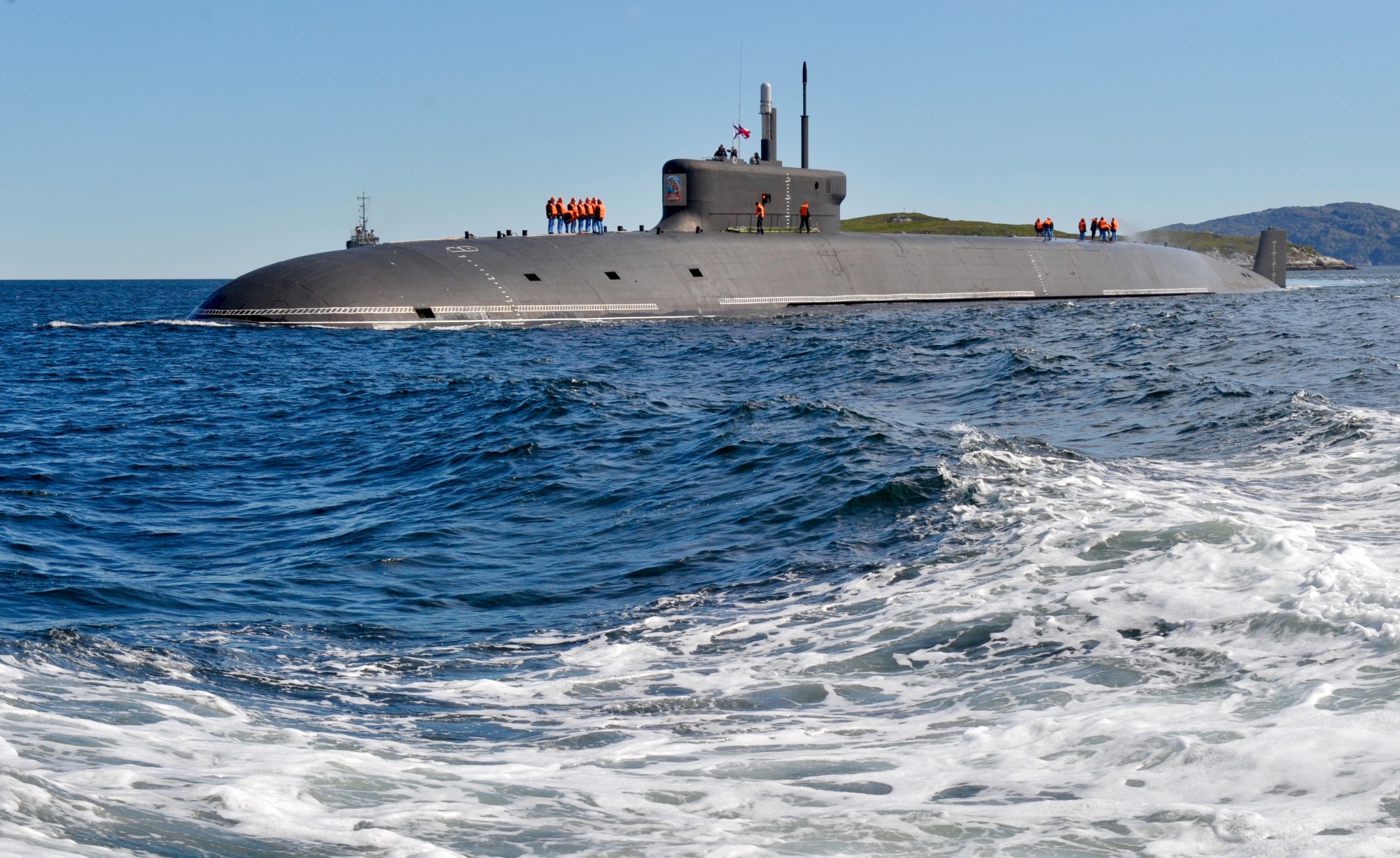
Patrol Entertainment
Life was never dull on submarine patrols.
One of the highlights was entertainment on the SRE (Sound Reproduction System), the piped music system on which 'concerts' could be broadcast round the tiny messdecks. Three unique audio tapes of such concerts are attached below in the Imperial War Museum link.
HMS Andrew (1969)
The first, in November 1969, in HMS Andrew, is of our St. Andrew's Night Concert. It was recorded in the middle of a submarine versus submarine exercise to the west of the Hebrides. As we were up against the nuclear-powered HMS Valiant and USS Nautilus, the world's first nuclear-powered submarine, we didn't stand a chance. So the concert became our main priority. As we went deep and quiet to hold the concert, we baffled the Exercise analysts. They could not figure out why Andrew had simply disappeared for 24 hours.
HMS Revenge (1978)
The other tapes are from Revenge and were recorded on strategic nuclear deterrent patrols. 'Royal Divisions in the Floating Dock' is a spoof inspection of the ship's company by Her Majesty the Queen in the ludicrous setting of the dock bottom of AFD60, the floating dock, at Faslane. 'How the Mess Was Won' is a pseudo wild western tale in which Big Bad Barry, the Executive Officer (XO), denies the Stokers their own mess deck. It's a true story set to music - country and western of course.
IMPERIAL WAR MUSEUM
In early autumn 2017, I responded to an Imperial War Museum (IWM) request, via the Submariners’ Association, for Cold War memorabilia, and contacted the Museum with the offer of some unique tape recordings of submarine concerts on patrol. Would you believe it? The curator who was seeking this stuff turned out to be the son of Petty Officer Medical Assistant ‘Doctor’ Proctor of my Revenge crew; he is actually mentioned by name in the spoof 'Royal Divisions in the Floating Dock' tape? As a result, I went down to the IWM to be interviewed and met up with the aforementioned 'Doctor Procto'r; I hadn’t seen him since 1978, only forty years previously! The upshot was that I was photographed, interviewed, classified, damn nearly mummified and filed in the National Archives. Yes, I am now a certified relic.
Here is the link to the article in the Museum’s website with the tapes of the patrol concerts
LINK TO IMPERIAL WAR MUSEUM RECORDINGS
http://www.iwm.org.uk/history/radio-revenge-entertainment-on-cold-war-submarines
San Juan Tragedy
The disappearance of the Argentine Navy submarine San Juan in 2017 is a reminder of the risks faced by submariners in the service of their countries. Submarine disasters are rare but submariners are exposed constantly to multiple hazards and must continuously observe strict safety disciplines. Even so, problems can arise which are beyond the control of even the best-drilled crew. The greatest hazards are fire, flood, explosion, collision, material failure, toxic atmosphere and, in the case of nuclear boats, radioactivity. These exist without enemy action.
The San Juan was a German-built, diesel-electric submarine. She entered Argentine Navy service in 1985, was thirty-two years old and no doubt suffered age problems. Indeed, she was returning to base because of a main battery fault, a two thousand mile voyage in hostile sea conditions. In diesel-electric submarines, the battery is crucial; it is the only source of power when below periscope depth. Without electrical power, a diesel-electric submarine can neither propel nor pump out excess water which may be causing her to sink. USS Thresher sank in 1963 with all 129 crewmembers lost. She should have had nuclear power to drive her up to safety but her reactor had shut down automatically as a result of her flooding.
As San Juan sent no further signals after reporting a battery problem, it may be concluded either that she had lost electrical power, at least to her radios; was below periscope depth and unable to transmit; or her crew had been incapacitated; or all three. The Comprehensive Nuclear Test Ban Treaty Organisation (CTBTO) in Vienna reported an unexplained non-nuclear explosion in the South Atlantic at the time of the San Juan‘s disappearance. That explosion could have been either an internal explosion or the hull collapsing at depth whilst sinking to the deep ocean floor. An internal explosion could have been caused by hydrogen coming from a damaged battery system or by a torpedo detonating, the former seeming more likely given the known battery problem. The explosion could have incapacitated her crew, caused a major leak, and denied her all power.
Hull collapse would have been inevitable if she was off the continental shelf and sinking. Above a certain depth, the crew could have blown her buoyancy tanks – that does not require electrical power – and surfaced, but in heavy seas she would still require power to retain buoyancy. If the atmosphere on-board was toxic following an explosion, the crew, if still alive, would then have faced the option of death by gas poisoning or by drowning – there is no upper deck on a submarine and liferafts are not carried.
The disappearance of the San Juan may never be explained though loss of all electrical power due to a battery explosion seems most likely. In 2000, Russia’s Kursk was lost due to a torpedo explosion. The Soviet Komsomolets sank in 1989 as a result of a devastating fire. In 1963, the USS Thresher sank due to flooding caused by a burst seawater pipe. The cause of the last British loss, HMS Affray, in 1951, remains unknown but is thought to have been due to material failure whilst snorting (snorkelling). A few men escaped from Komsomolets only to be drowned; the other boats sank with loss of all hands. Submarines do not fail safe.
Post Scriptum
One week later, the Argentine Navy finally released the information that the San Juan's last message had been that water had come into the engine room via her snort (snorkel) mast, drained into her after battery compartment and short circuited the main battery. That almost certainly meant shorting out her main electrical power system and denying her all power. Seawater entering an acid filled battery would also have led to the generation of deadly chlorine gas. The submarine had in effect been turned into a gas chamber. What a hellish way to die: sinking, gas poisoning, violent seas and pitch darkness.
Speculation
The big unanswered question is why did the submarine not surface and call for help as soon as it was in trouble? That would have been the natural thing for a submarine to do. This leads to some speculation. The Argentine Navy also released a track chart showing where the submarine was said to have disappeared. That track passes relatively close to the British held Falkland Isles.
There is evidence that the Argentine Navy has been spying on the Falklands; they would, would they not? We would in their situation. So, could it be that the San Juan did not surface in emergency because she was in British territorial waters? Argentine Navy HQ may have told her to get out of British waters before surfacing. That could also explain the Argentine Navy's delay in announcing her disappearance. By the time she had cleared British waters submerged, it was too late. RIP
ANALYSIS BY US OFFICE OF NAVAL INTELLIGENCE
An analytical review of all information released by the Comprehensive Nuclear-Test-Ban Treaty Organization on the acoustic signal associated with the loss of the Argentina Submarine San Juan confirms the following:
● That acoustic signal originated near 46-10S, 59-42W at 1358Z (GMT) on 15 November 2017. *It was produced by the collapse (implosion) of the pressure-hull at a depth of 1275-feet. Sea pressure at the collapse depth was 570 PSI.
● The frequency of the collapse event signal (bubble-pulse) was about 4.4 Hz.
● The energy released by the collapse was equal to the explosion of 12,500 pounds of TNT at the depth of 1275-feet.
● That energy was produced by the nearly instantaneous conversion of potential energy (sea-pressure) to kinetic energy, the speed of the intruding water-ram entering the SAN JUAN pressure-hull was about 1800 mph.
● The entire pressure-hull was completely destroyed (fragmented/compacted) in about 40 milliseconds (0.040s or 1/25th of a second), the duration of the compression phase of the collapse event which is half the minimum time required for cognitive recognition of an event.
● Although the crew may have known collapse was imminent, they never knew it was occurring.
● They did not drown or experience pain. Death was instantaneous.
● The SAN JUAN wreckage sank vertically at an estimated speed between 10 and 13 knots. Bottom impact would not have produced an acoustic event detectable at long range*.
■The open questionis: ... *Why was no corrective action - such as blowing ballast - taken by the SAN JUAN crew before the submarine sank to collapse depth?
According to Argentine Navyspokesman Gabriel Galeazzi, the Commanding Officer of the SAN JUAN reported a "failure" in thesubmarine's "battery system". The time of that report was 0730 on 15 November, assumed to have been GMT. Subsequently, the problem was reported to have been "fixed". The SAN JUAN intended to submerged and continued its transit north. The SAN JUAN pressure-hull collapsed at 1358 GMT on 15 November.
In the case of the loss of the US nuclear submarine SCORPION, hydrogen gas from the main battery exploded at 18:20:44 GMT on 22 May 1968 incapacitating/killing the crew with an explosion in the battery well, estimated to have been 7-10 times the fatal value. The pressure-hull was not breached. This assessment was based on analysis of acoustic detections of the event and damage observed in pieces of the fragmented battery recovered from the wreckage at a depth of 11,100 feet by the US submersible TRIESTE. There was no flooding of the pressure-hull before the battery exploded. SCORPION lost power and sank slowly over nearly 22 minutes to hull collapse at a depth of 1530-feet at 18:42:34 GMT on 22 May 1968.
There is the possibility that a similar sequence of events occurred aboard the SAN JUAN. If the wreck is located and efforts are made to recover components, emphasis should be placed on the battery system.
Bruce Rule
Lead acoustic analyst at the US Office of Naval Intelligence
